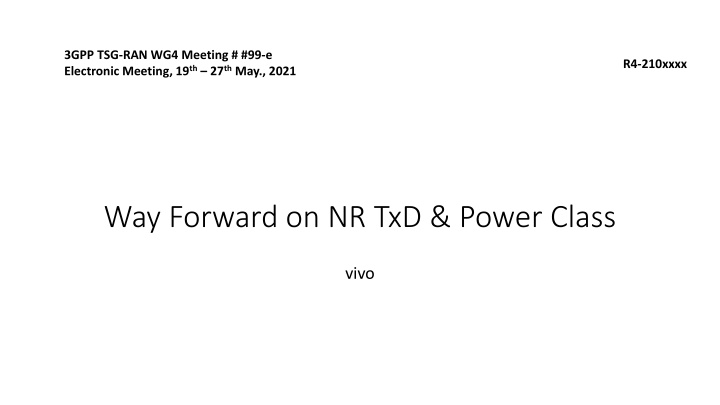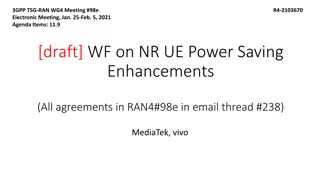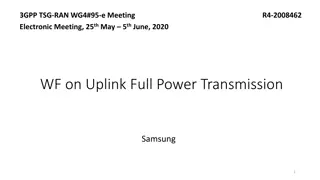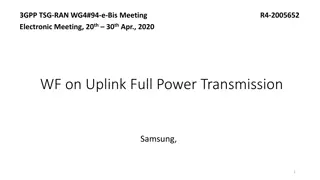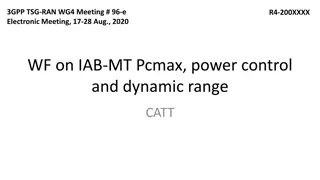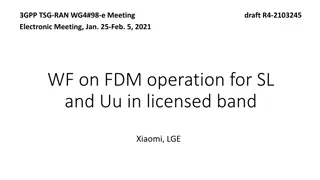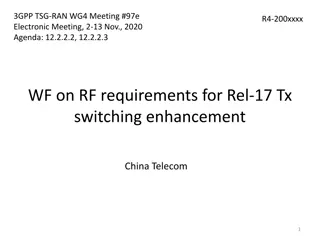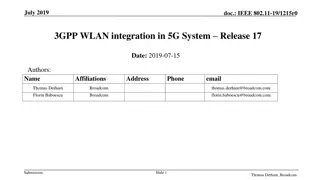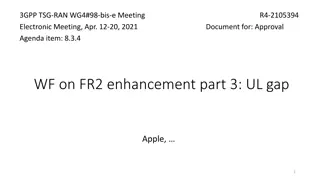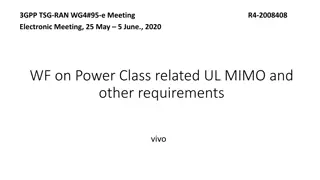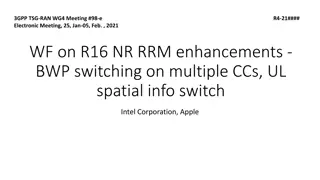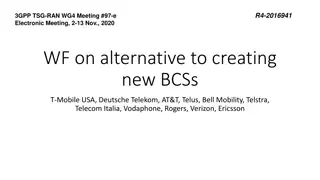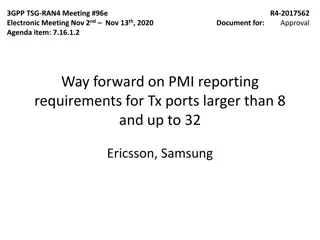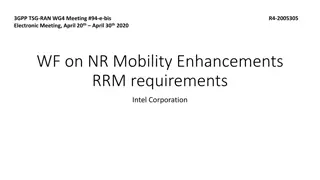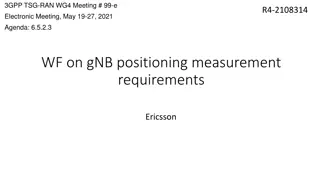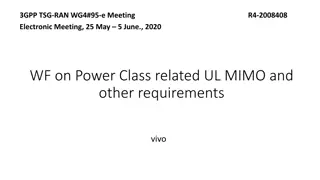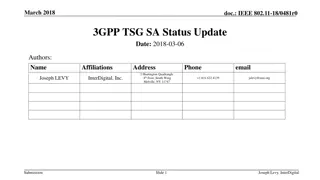Way Forward on NR TxD & Power Class in 3GPP Meeting
Clarify proposals and agreements regarding power class for capability signaling in different releases, relation with full power capability, SRS antenna switching, non-codebook based transmission, and other multi-antenna features in the electronic 3GPP TSG-RAN meeting.
Download Presentation

Please find below an Image/Link to download the presentation.
The content on the website is provided AS IS for your information and personal use only. It may not be sold, licensed, or shared on other websites without obtaining consent from the author.If you encounter any issues during the download, it is possible that the publisher has removed the file from their server.
You are allowed to download the files provided on this website for personal or commercial use, subject to the condition that they are used lawfully. All files are the property of their respective owners.
The content on the website is provided AS IS for your information and personal use only. It may not be sold, licensed, or shared on other websites without obtaining consent from the author.
E N D
Presentation Transcript
3GPP TSG-RAN WG4 Meeting # #99-e Electronic Meeting, 19th 27thMay., 2021 R4-210xxxx Way Forward on NR TxD & Power Class vivo
LS related - Applicable power class for capability signaling in different releases o Proposals: Option 1: Applies for all Power Classes for both Rel-15 and Rel-16 Option 2: Applies for only PC2 for Rel-15, and for all power classes in Rel-16; Option 3: Others Agreement(GTW): Option 1
LS related - Relation with full power capability Clarify the relationship between transparent TxD capability signalling and full Tx power capability Proposals Option 1: No dependency Option 2: A UE can support only one of the two capabilities o Agreements: [Option 1]
LS related - Relation with SRS antenna switching Clarify the relationship between transparent TxD capability signalling and SRS antenna switching Proposals Option 1: No dependency Option 2: A UE that supports 1T2R antenna switching SRS should have at least one full power PA In another word, transparent TxD UE capable UE with an architecture of 23+23 for PC2, are not allowed to be 1T2R antenna switching capable Option 3: Others o Agreements: [Option 1]
LS related - Relation with Non-codebook based transmission Clarify the relationship between transparent TxD capability signalling and non-codebook based transmission Proposals Option 1: No dependency Option 2: Non-codebook based UEs required full power PAs per Tx chain for power efficient operation. Option 3: Others o Agreements: FFS
LS related - Relation with other multi-antenna features Clarify the relationship between transparent TxD capability signalling and other multi-antenna features Proposals Option 1: No dependency Option 2: A TxD capable UE can indicate support for a feature only if UE behavior and performance for the feature is unaffected by TxD capability. Option 3: Others o Agreements: FFS
Remaining Issues - MPR Proposals Following offset range based on 1TX was proposed. Modulation MPR (dB) Edge RB allocations Outer RB allocations Inner RB allocations Pi/2 BPSK 3.5 0.5 0 QPSK 3.5+D1 1+D2 0+D6 16 QAM 3.5+D1 2+D2 1+D6 DFT-s-OFDM 64 QAM 3.5+D3 2.5+D4 256 QAM 4.5 + [1] QPSK 3.5+D1 3+D2 1.5+D6 16 QAM 3.5+D1 3+D2 2+D6 CP-OFDM 64 QAM 3.5+D5 256 QAM 6.5 + [2] Agreements option 1 option 2 Edge MPR for QPSK/16QAM (D1): [0.5~1.5]dB Outer MPR for QPSK/16QAM (D2): [0.5~1.5]dB Edge DFT-S MPR for 64QAM (D3): [0.5~1.5]dB Outer/Inner DFT-S MPR for 64QAM (D4): [0.5~1.5]dB CP-OFDM MPR for 64QAM (D5): [0.5~1.5]dB Inner (other than High order) (D6): [0~0.5]dB 256QAM proposals marked in the table; Pi/2 BPSK currently leave unchanged Pi/2 BPSK currently leave unchanged (D1): [0.5~3.0]dB (D2): [0.5~2.5]dB (D3): [0.5~3.0]dB (D4): [0.5~2.0]dB (D5): [0.5~2.0]dB (D6): [0~1.5]dB 256QAM proposals marked in the table; Agreement : Detail MPR values will be determined in next RAN4 meeting based on MPR simulation results
Remaining Issues - TxD EVM spectrum flatness Proposals Based on R4-2108793 with the following updated equation for composite equalizer: ??(?) =?1 |??1? | + ?2 |??2(?)| ?1+ ?2 o Agreements : [Suggestion Confirmed]
Remaining Issues - Testing related issues Proposals Option 1: Leave these discussions to RAN5 and not pursue them before agreement of RAN4 CR. Option 2: Continue discussion in RAN4. o Agreements : [Option 1]
Remaining Issues - TxD antenna and channel models Proposals Option 1: No more discussion on these issues. Option 2: Further discuss the relevant antenna and channel models and their impact as part of, and prior to, concluding on conformance testing methodologies and reference receivers for TxD with conducted measurements. o Agreements : [Option 1]
Power class related- The Pcmax for NR for Rel-15 EN-DC Proposals Option 1: The Pcmax for NR is modified to use the lower possible power class to decide the lower bound of the configured power. (Huawei) Option 2: The Pcmax for NR is modified according to the declared NR power capability for NSA so that the PHR becomes correct. (Ericsson) Option 3:Do not consider further refinements of Pcmax for NR. Option 4: Others o Agreements : FFS
Power class related- Fallback to 1-port Tx for SA in Rel- 15 Proposals Option 1: Confirm ue-PowerClass should always be supported for 1-port transmission fall back mode for SA in Rel-15. UE do not support TxD capability would equip a full power chain For UE support TxD capability, when falls back to 1-port transmission, it is also reasonable to suppose it would use TxD to achieve ue-PowerClass in standalone mode Option 2: Others o Agreements : Option 1 [Rel-15 CR would be introduced to clarify the understanding]
